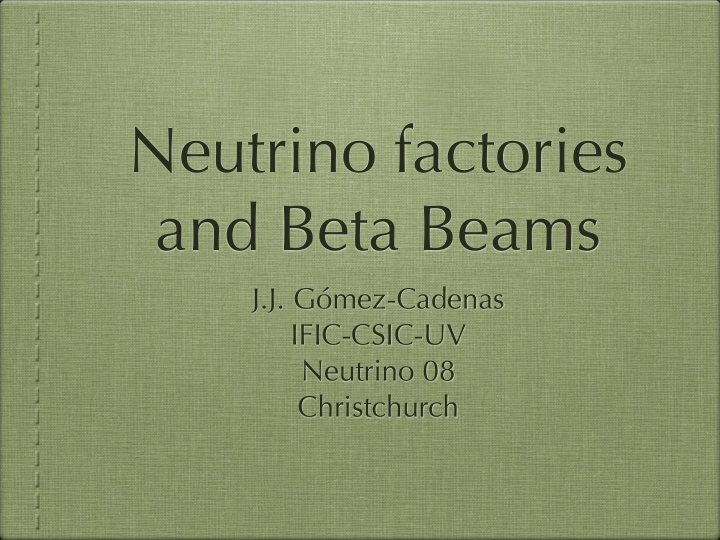



Neutrino factories and Beta Beams J.J. Gómez-Cadenas IFIC-CSIC-UV Neutrino 08 Christchurch
Madrid & Chicago candidatures being prepared for Olympics What are our candidates for a future neutrino physics facility?
nufact beta-beam Iron TASD super-beam We wish we knew! Mton LAr
Measurement of sin 2 θ 13 : Correlations At fixed E,L, the equation αβ ( θ 13 , δ ) = P αβ ( θ 13 , δ ) P Has a continuum of solutions (the equiprobability curve).
Measurement of sin 2 θ 13 :Intrinsic degeneracy For neutrinos and antineutrinos at fixed E,L, the equation ± ( θ 13 , δ ) = P ± ( θ 13 , δ ) P αβ αβ has two intersections. The true solution and a clone of “ghost” ENERGY DEPENDENT solution
Solving Intrinsic degeneracy: Recipe 1 Neutrino beams are not monochromatic Spectral analysis in detectors with good energy resolution allows to combine several “monochromatic” energies, each one with the clone in a different place Use of two different baselines changes E/L by a very significant factor, separating dramatically the clones
Solving Intrinsic degeneracy: Recipe 2 Include other oscillation channels such as the “silver” channel
Discrete degeneracies Two other sources of degeneracy. 2 ) s atm = sgn( Δ m 23 1. Ignorance of the sign of Δ m 23 2 s oct = sgn(tan(2 θ 23 )) 2. Ignorance of the octant of θ 23 These two discrete values assume the value ± 1
LE ββ HE ββ Three degeneracies (intrinsic, sign, octant) for 2 3 = 8 combinations
Super Beams A v High power (1-4 MW) Large detector Narrow band beam Energy near 1 GeV (QE range)
sin 2 2 θ 13 → 4 × 10 − 3 Better for δ near π /2, but strongly affected by correlations and systematic errors Understanding background systematics to the level of 2% is very challenging Excellent measurement of atmospheric parameters Little sensitivity to mass effects max CPV → 6 − 8 × 10 − 3
Beta Beam
ν e → ν µ → µ ( CC , QE ) ν e ( NC ) → 1 π ( Δ )
Outperforms super-beam both in reach for θ 13 , δ and sensitivity to ME Sensitivity to ME spoiled by sign(matter) ambiguity. This can be solved by combining with atmospheric data A HE- bbeam with a Mton class detector and using atmospherics has an excellent physics case
The neutrino factory
The “standard” neutrino factory 25-50 GeV stored energy muons
Nufact and degeneracies The Golden muon measurement is affected by degeneracies, given the high energy of the neutrino factory This results in first oscillation peak to be at some 3000 km, were matter effects are already very strong It was understood since the beginning that the optimal performance of the nufact required to break degeneracies This requires: a) An improved detector b) Two baselines c) Combination with other channels A. Donini
Silver channels 1 mm τ ν Pb Emulsion layers
No magic baseline for nufact 3000km 750km 7500 km
Or maybe yes... T wo baselines seem to be a must for optimal performance: “near”: 3000-4000 km, for CP violation “MB”: 7500 km for matter effect and maximum sensitivity to sin 2 θ 13
An improved detector
And the winner is... A neutrino factory with two baselines and improved detector reaches best sensitivity Engineering and detector challenges not trivial Two baselines can also improve beta- beam and super-beam
Which Road to take?
Build a Mton detector? ν µ → ν e ν e → ν µ
Combine Super-Beam and Beta-Beam in one facility? Using CPT conjugated channels for optimal sensitivity to mass hierarchy
Combine two ions at a fixed baseline to solve degeneracies?
A low energy nufact?
A low energy nufact with non magnetic detectors? E=5 GeV Gd doping tags n ν µ → ν τ In peak thus ν µ In peak
Two baselines, two ions beta-beam? Sensitivity similar to a neutrino factory?
Too many combinations? dreaming too big?
I hope we choose well
Recommend
More recommend